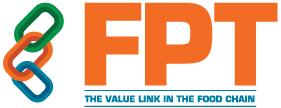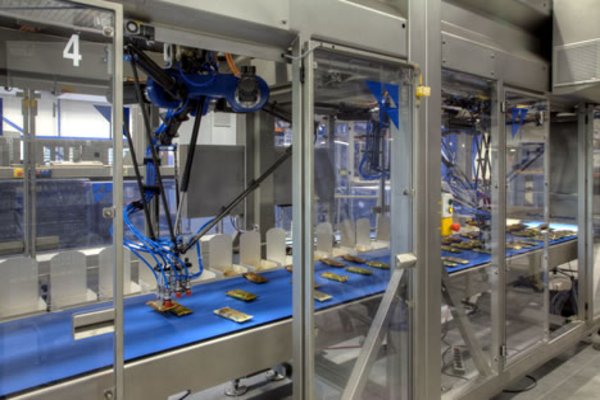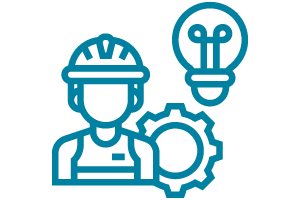Pick and Place Machine
How Pick and Place Machines Work
Picking up a component from one location and placing it in another is how all automated Pick and Place Machines work. Rather than utilizing fingers or tweezers like a human operator, the pick and place employs a tiny suction nozzle to push against the component and hold it in place with suction.
Once the nozzle gets a solid grip on the component, it raises it and inserts it where it is needed, immediately releasing the suction. While the Pick and Place Machine, or Pick and Place Machinery, is programmed with the component's original and final positions, slight deviations in placement can occur. Then, using computer vision, these positions are validated, ensuring that the board is indeed in the desired position.
It also ensures that the nozzle picks up the component. Fiducials and tooling holes are commonly referenced in discussions of automated machines since both are used by computer vision as references. Fiducials are made specifically for this purpose, whereas tooling holes are made primarily to keep boards or panels in place mechanically, but they can also be used as reference points.
The great majority of Pick and place machines use a Cartesian Coordinate System, with the head moving in the X and Y axes for the most part. The nozzle may move up and down on the Z-axis to choose components, however, the majority of movement is two-dimensional.
There is now experimentation on constructing Delta Pick and Pick and Place Machines based on comparable designs for 3D printers, particularly in the low-cost, do-it-yourself community. Pick and Place Machines are becoming increasingly popular because of their mechanical simplicity and inexpensive cost, even though the mathematics behind the movement is slightly more challenging.
The delta Pick and place machine gets much higher to handle the side-to-side motion as the X and Y-axis needs increase, making the overall machine fairly ungainly with the arms becoming longer, heavier, and more prone to mistakes. Also, because the delta motion is a lower-cost machine, it is less likely to include a spinning feature on the tip, as well as other characteristics. Cartesian-based systems are significantly easier to scale, and the two-dimensional structure of the system allows for faster movement. It has also had more time to be tuned for speed, accuracy, and cost because it is an older, more established technology.
How Pick and Place Machines are Assembled
Pick and Place Machines do not have to be confined to a single nozzle. Even at the lowest end, alternative nozzles will most likely be available to attach to the head, albeit the switch will have to be done manually.
Pick and place on higher-end computers, on the other hand, may employ numerous heads at once. This can be done in a variety of ways, such as switching nozzles to handle a bigger or smaller component or utilizing separate nozzles to grasp many components of the same size at the same time.
There is a lot of room for creativity when it comes to making decisions. With this versatility comes a degree of difficulty in accurately selecting and using the nozzles. Their size must be considered in the system's design; they must be tiny enough to attach to the tiniest pieces while yet being large enough to support the weight of the larger elements.
The Pick and Place Machine must also be properly grounded to avoid tiny items from getting electrostatically linked to the nozzle rather than remaining in their proper location on the board. In these cases, solder paste comes in handy since it works as an adhesive to keep the component in place.
Solder paste can be applied to the board in several different ways. The automated use of stencils is the most prevalent for big production runs. Stencils are created by drilling holes in a metal or plastic sheet where solder is required on the board.
These are made using the solder paste Gerber file's metadata. This stencil is put on top of the board or panel of boards and precisely positioned so that the holes in the stencil match up with the pads on the board before entering the Pick and Place Machine.
A generous dollop of solder paste is applied to the top of the stencil and then dragged across it with a squeegee. The solder paste is poured into the stencil's holes, covering all of the pads.
Some Pick and place machines, on the other hand, are equipped with solder paste depositing nozzles that will deposit individual dollops of solder paste on each pad for extremely tiny prototype runs when a stencil is not worth the effort or money. On a per-unit basis, this is slower, but it saves money and reduces the time it takes for the stencil to arrive after ordering.
Features of pick and place machines.
The flexibility of Pick and Place Machines in terms of component sources is one of their most appealing qualities. Anyone who has made an order with an electronics distributor has observed a variety of alternative methods to receive their parts, the most common of which being Tape Reel and Tube, with variants such as chopped tape and bespoke reels. Because they are perfect for use in Pick and place machines, tape and reel, as well as tube, are particularly popular among distributors.
Small holes can be found on one side of the tape on reels of components, similar to the paper used in antique printers. The majority of Pick and Place Machines can extract parts from various sources, such as trays or even bespoke plates. Instead of needing extra manual monitoring while switching out the trays, this is done. This isn't as big of an issue for tiny runs.
Advantages of Pick and place machines
The advantages of having a Pick and Place Machines, machine in-house include greater flexibility, less time spent explaining a project to others, and a possibly reduced lifetime cost. If the Pick and place machines are just being used for prototype or 100-piece production runs, a smaller batch of Pick and place machines with a single head would most likely suffice.
More attention should be placed on the simplicity with which a design can be changed and the flexibility with which modest quantities of parts may be accepted. If this Pick and place machine is part of a new and significant production process that produces vast numbers of only a few types of items, there will be a greater emphasis on speed optimization.
Pick and Place Machines aided in the acceleration of the electronics revolution by allowing designers and manufacturers to build huge numbers of electronics in a short amount of time. It will be possible to make better use of time and resources by identifying their strengths and limitations, knowing what to use and when, and comprehending the influence on all aspects of design and logistics. By properly balancing the various aspects of manufacturing and prototyping, bottlenecking may be reduced and deadlines can be met more easily.
Limitations and Drawbacks of pick and place machines.
Pick and Place Machines are remarkable instruments, but they are not without their flaws and limits. Miscommunications do occur, as they do with every computer system that interacts with physical reality. Pick and places occasionally fail to pick up their intended part, lose it in transit, or fail to drop it off at the designated destination.
Several procedures may be taken to lessen the chances of this happening, including human supervision and computer vision. These safeguards, on the other hand, are intended to remedy rather than avoid faults. Furthermore, many pieces, particularly the little passives, are effectively lost once dropped.
They are frequently abandoned since their size and cost do not merit a search and replacement. As a result, assembly houses frequently seek overages in the parts they get. If the Pick and place machine is not given all of the information it needs, it may have trouble striking items that stick out vertically from the board. While not frequent, this can cause major damage and misalignment to the equipment and should be avoided.
Our principals
Manufacturers of food and personal care items place a premium on quality, hygiene, and uniform packaging. Blueprint Automation creates, builds, distributes, and maintains packaging solutions that match all of these criteria and more for your industry. Kiron Food Processing Technologies collaborates to design a customized solution that ensures optimal production by combining your demands with our innovative strength and modular solutions. Of course, full compliance with the highest quality, health, and safety requirements is always a component of the answer.










